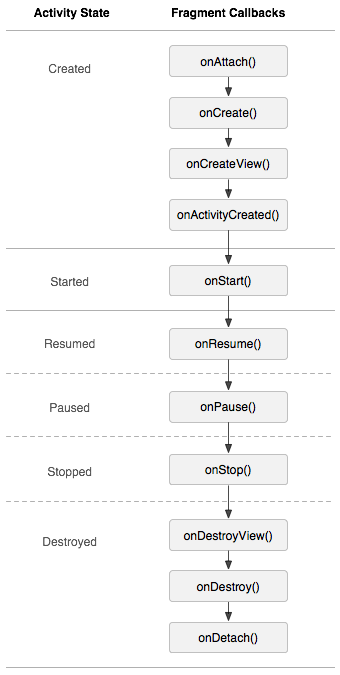[TOC]
## 生命周期

可以看到Fragment比Activity多了幾個額外的生命周期回調方法:
**onAttach(Activity)**
當Fragment與Activity發生關聯時調用。
**onCreateView(LayoutInflater, ViewGroup,Bundle)**
創建該Fragment的視圖
**onActivityCreated(Bundle)**
當Activity的onCreate方法返回時調用
**onDestoryView()**
與onCreateView想對應,當該Fragment的視圖被移除時調用
**onDetach()**
與onAttach相對應,當Fragment與Activity關聯被取消時調用
注意:除了onCreateView,其他的所有方法如果你重寫了,必須調用父類對于該方法的實現
## 靜態使用Fragment
1. 繼承Fragment,重寫onCreateView決定Fragemnt的布局
2. Activity中聲明此Fragment,就當和普通的View一樣
~~~
<RelativeLayout xmlns:android="http://schemas.android.com/apk/res/android"
xmlns:tools="http://schemas.android.com/tools"
android:layout_width="match_parent"
android:layout_height="match_parent" >
<fragment
android:layout_below="@id/id_fragment_title"
android:id="@+id/id_fragment_content"
android:name="com.zhy.zhy_fragments.ContentFragment"
android:layout_width="fill_parent"
android:layout_height="fill_parent" />
</RelativeLayout>
~~~
## FragmentTransaction
~~~
<RelativeLayout xmlns:android="http://schemas.android.com/apk/res/android"
xmlns:tools="http://schemas.android.com/tools"
android:layout_width="match_parent"
android:layout_height="match_parent" >
<FrameLayout
android:id="@+id/id_content"
android:layout_width="fill_parent"
android:layout_height="fill_parent"
android:layout_above="@id/id_ly_bottombar"
android:layout_below="@id/id_fragment_title" />
</RelativeLayout>
~~~
~~~
FragmentManager fm = getFragmentManager();
FragmentTransaction transaction = fm.beginTransaction();
ContentFragment mWeixin = new ContentFragment();
transaction.replace(R.id.id_content, mWeixin);
transaction.commit();
~~~
### FragmentManager
主要用于在Activity中操作Fragment
通過getFragmentManager() // v4中,getSupportFragmentManager獲取
### FragmentTransaction
保證一些列Fragment操作的原子性,熟悉事務這個詞,一定能明白
FragmentTransaction transaction = fm.**benginTransatcion();**
/開啟一個事務
**transaction.add()**
往Activity中添加一個Fragment
**transaction.remove()**
從Activity中移除一個Fragment,如果被移除的Fragment沒有添加到回退棧(回退棧后面會詳細說),這個Fragment實例將會被銷毀。
**transaction.replace()**
使用另一個Fragment替換當前的,實際上就是remove()然后add()的合體~
**transaction.hide()**
隱藏當前的Fragment,僅僅是設為不可見,并不會銷毀
**transaction.show()**
顯示之前隱藏的Fragment
**detach()**
會將view從UI中移除,和remove()不同,此時fragment的狀態依然由FragmentManager維護。
**attach()**
重建view視圖,附加到UI上并顯示。
**transatcion.commit()**
提交一個事務
**addToBackStack("fname")**
可選的。FragmentManager擁有回退棧(BackStack),類似于Activity的任務棧,如果添加了該語句,就把該事務加入回退棧,當用戶點擊返回按鈕,會回退該事務(回退指的是如果事務是add(frag1),那么回退操作就是remove(frag1));如果沒添加該語句,用戶點擊返回按鈕會直接銷毀Activity。
注意:常用Fragment的哥們,可能會經常遇到這樣Activity狀態不一致:State loss這樣的錯誤。主要是因為:**commit方法一定要在Activity.onSaveInstance()之前調用。**
上述,基本是操作Fragment的所有的方式了,在一個事務開啟到提交可以進行多個的添加、移除、替換等操作。
值得注意的是:如果你喜歡使用Fragment,一定要清楚這些方法,哪個會銷毀視圖,哪個會銷毀實例,哪個僅僅只是隱藏,這樣才能更好的使用它們。
## 用法
* 我在FragmentA中的EditText填了一些數據,當切換到FragmentB時,如果希望會到A還能看到數據,則適合你的就是hide和show;也就是說,**希望保留用戶操作的面板,你可以使用hide和show**,當然了不要使勁在那new實例,進行下非null判斷。
* 我不希望保留用戶操作,你可以使用remove(),然后add();或者使用replace()這個和remove,add是相同的效果。
* remove 和 detach有一點細微的區別,在不考慮回退棧的情況下,remove會銷毀整個Fragment實例,而detach則只是銷毀其視圖結構,實例并不會被銷毀。那么二者怎么取舍使用呢?如果你的當前Activity一直存在,那么在不希望保留用戶操作的時候,你可以優先使用detach。
## 參考資料
[Android 進階17:Fragment FragmentManager FragmentTransaction 深入理解](https://blog.csdn.net/u011240877/article/details/78132990)
[Android Fragment 非常詳細的一篇](https://www.jianshu.com/p/11c8ced79193)
[Android Fragment 真正的完全解析(下)](https://blog.csdn.net/lmj623565791/article/details/37992017)
[Fragment的相關用法第三篇(張鴻洋)](https://blog.csdn.net/u010597493/article/details/53992732)
- Android
- 四大組件
- Activity
- Fragment
- Service
- 序列化
- Handler
- Hander介紹
- MessageQueue詳細
- 啟動流程
- 系統啟動流程
- 應用啟動流程
- Activity啟動流程
- View
- view繪制
- view事件傳遞
- choreographer
- LayoutInflater
- UI渲染概念
- Binder
- Binder原理
- Binder最大數據
- Binder小結
- Android組件
- ListView原理
- RecyclerView原理
- SharePreferences
- AsyncTask
- Sqlite
- SQLCipher加密
- 遷移與修復
- Sqlite內核
- Sqlite優化v2
- sqlite索引
- sqlite之wal
- sqlite之鎖機制
- 網絡
- 基礎
- TCP
- HTTP
- HTTP1.1
- HTTP2.0
- HTTPS
- HTTP3.0
- HTTP進化圖
- HTTP小結
- 實踐
- 網絡優化
- Json
- ProtoBuffer
- 斷點續傳
- 性能
- 卡頓
- 卡頓監控
- ANR
- ANR監控
- 內存
- 內存問題與優化
- 圖片內存優化
- 線下內存監控
- 線上內存監控
- 啟動優化
- 死鎖監控
- 崩潰監控
- 包體積優化
- UI渲染優化
- UI常規優化
- I/O監控
- 電量監控
- 第三方框架
- 網絡框架
- Volley
- Okhttp
- 網絡框架n問
- OkHttp原理N問
- 設計模式
- EventBus
- Rxjava
- 圖片
- ImageWoker
- Gilde的優化
- APT
- 依賴注入
- APT
- ARouter
- ButterKnife
- MMKV
- Jetpack
- 協程
- MVI
- Startup
- DataBinder
- 黑科技
- hook
- 運行期Java-hook技術
- 編譯期hook
- ASM
- Transform增量編譯
- 運行期Native-hook技術
- 熱修復
- 插件化
- AAB
- Shadow
- 虛擬機
- 其他
- UI自動化
- JavaParser
- Android Line
- 編譯
- 疑難雜癥
- Android11滑動異常
- 方案
- 工業化
- 模塊化
- 隱私合規
- 動態化
- 項目管理
- 業務啟動優化
- 業務架構設計
- 性能優化case
- 性能優化-排查思路
- 性能優化-現有方案
- 登錄
- 搜索
- C++
- NDK入門
- 跨平臺
- H5
- Flutter
- Flutter 性能優化
- 數據跨平臺
